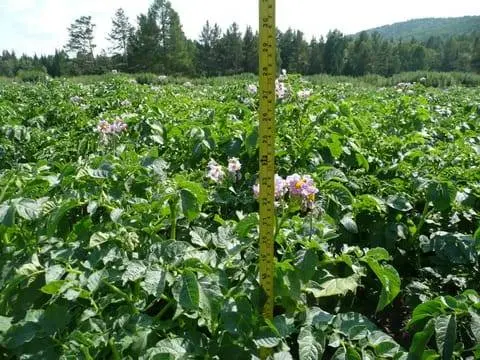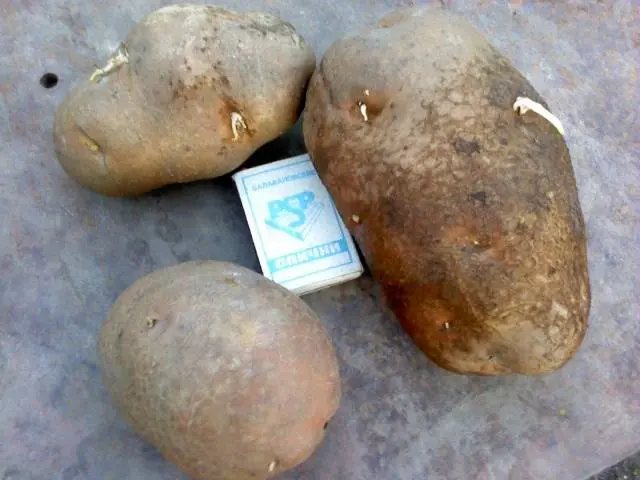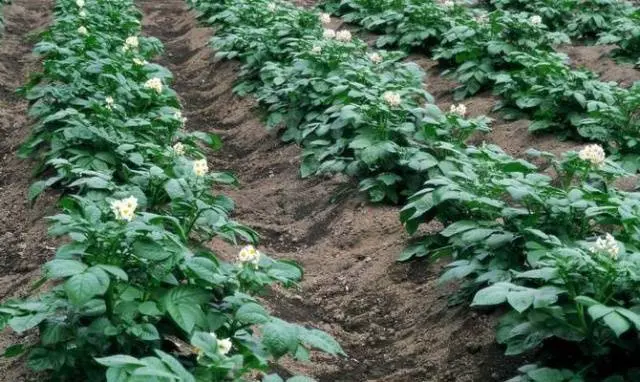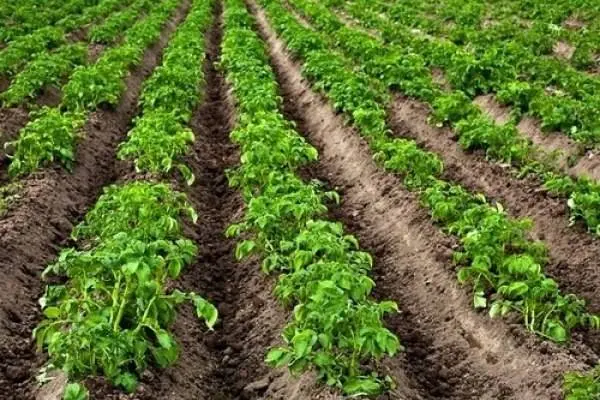Contents
Probably, not only every schoolboy, but also many kids know that the edible parts of potatoes are underground. From childhood, many people remember the fairy tale “Tops and Roots”, where a cunning peasant deceived a greedy and lazy bear who wanted to do nothing, but with the help of threats to receive his share of the harvest. So in the case of potatoes, he received exactly half the crop by weight – “tops”, which he did not know what to do with, because they turned out to be completely inedible.
True, in the modern world, the aerial parts of potato bushes are also used. Potato tops are used to prepare special infusions to control insect pests. And if there is a significant amount of green mass, it can be composted and a valuable organic fertilizer can be obtained. Although you should not rejoice at the too large size of the leaves and stems of potatoes. After all, the size of potato tops does not have a direct effect on the yield. Of course, with a good potato harvest, as a rule, large and tall tops grow, but if its height approaches the meter mark, then it’s time to sound the alarm. In this case, the probability is too high that the tubers of such tops will ripen small and few.

Reasons for the intensive growth of tops
Why do potatoes have high tops? There are several answers to this question, and often the reason lies precisely in the wrong actions of the gardener himself.
Excess of nitrogen
It often happens that, acting out of the best of intentions, a person does not get exactly the result that was planned. Here, too, in this case, an excessive dose of fertilizers can lead to excessive growth of potato leaf mass, unfortunately, to the detriment of tuber yields.
An excess of these fertilizers leads to the fact that the tops of potatoes can grow to a meter or more in height. But the tubers hardly develop at the same time, and the harvest will be unsatisfactory.

What to do when the tops have already grown? You can try to adjust the top dressing. Superphosphate is best suited for these purposes. Of course, the tops of this will not go anywhere, but stimulation will be given to the process of tuberization. After all, superphosphate has the ability to accelerate the aging process of potatoes and activate the outflow of nutrients from leaves to tubers. To prepare a nutrient solution, 10 g of superphosphate is diluted in 100 liters of hot water and potato bushes are shed with the resulting solution. This amount is enough to process one hundred acres of a potato field.

For the future, you need to know that if, when preparing beds for planting potatoes in autumn or spring, they were filled with manure or humus, then no additional nitrogen fertilizers are required for potatoes.
But top dressing with phosphorus, potassium, iron, magnesium and trace elements can be carried out several more times per season, especially if signs of starvation appear on the leaves: chlorosis, yellowing, and others.
In general, you need to be very careful with feeding potatoes. After all, even if the tops grow large and healthy, and the tubers will please with their size and quantity, potatoes oversaturated with fertilizers are poorly stored. And that means that all your good harvest may soon disappear. Therefore, it is advisable to carry out top dressing strictly according to the instructions and it is better to give less than to overfeed.
large tubers
For the same reason, when a gardener wants to do the best, and the result is not at all the best, he uses large tubers for planting.

What is going on? In large tubers, there is a correspondingly larger supply of nutrients. Therefore, potato plants grow intensively and increase their green mass in height mainly due to the tuber, while the root system almost does not develop. When the nutrition from the tuber ends, the plant begins to develop new tubers, but time has already been lost, the growing season is coming to an end and the tubers grow very small.
Lack of light
The simplest answer to the question: “Why do potatoes have high tops?” is the fact that plants may lack lighting. Probably everyone who has ever grown seedlings at home is well aware of this effect. If the level of illumination is low and the sprouts do not have enough light, then they begin to stretch strongly in height. So, potatoes planted in a shady or semi-shady place, in the struggle for additional lighting, begin to stretch upwards, closer to the sun.
The same effect can occur in a sunny location if the tubers are planted too close together. Potatoes do not respond well to planting density – they either begin to stretch or are affected by fungal diseases from poor air exchange in the beds.

Although in the southern regions, where there is so much sun that it is enough for everyone in abundance, even in semi-shady places, despite the high-growing stems, quite good potatoes can ripen.
Weather
If in all the above cases a lot depended on the actions of the gardener themselves, then no one is still able to influence the weather. And in the conditions of a warm and rainy summer, all the grass grows by leaps and bounds. Potato tops are no exception. And since the weather conditions are quite unpredictable, in this case, only one thing can be done. Wait for the potatoes to bloom and after a while trample down all the tops, so that they lie on the ground and can no longer take away nutrients from the tubers. As a result, all the energy of plants will go into tubers and you will be provided with a bountiful harvest.

What to do if the tops are low
In fact, the height of potato tops does not always negatively affect the potato yield. After all, there are many varieties that are characterized by a high aerial part. For them, the height of a potato bush within one meter is practically the norm.
You can worry only in those cases when you have grown a variety known to you for a long time, which suddenly stretched out a lot.
Everyone knows that the world is far from perfect, so while some are very worried about the large size of their potato tops, others are perplexed why their tops are so small.

If you’re trying out a new potato variety and are experiencing one of these problems, don’t worry until after you’ve harvested. Because potato varieties have very different characteristics and are found among them, including those whose tops do not grow above 40-50 cm. But at the same time, they can boast quite a decent yield – up to 25 tubers per bush. For example, the popular Red Scarlet potato variety has similar characteristics. The potato variety “Luck” also has very low tops. The short stature of the bushes is just a feature of some varieties.
But not everything is so simple. Unfortunately, the short stature of potato tops can also cause a lack of nutrients, primarily phosphorus. At the same time, the potato yield is sharply reduced. To verify the diagnosis, it is enough just to dig at least one tuber from under the bush and cut it into two parts. With phosphorus starvation, a purple hue will appear on the cut. Top dressing with superphosphate will help to cope with this problem, and it is better to carry it out in the form of spraying on the leaf.

Thus, do not be very upset if it seems to you that the tops of your potatoes do not look like the ones that grow in the neighbor’s garden. First you need to make sure that this is not a feature of the variety, and then take any measures.









